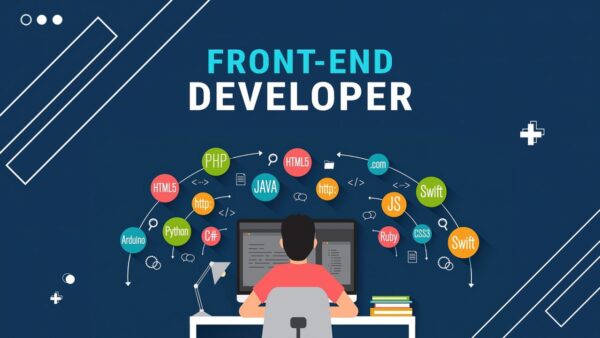The Dynamic World of Frontend Development: Building the Digital Experience
In the fast-paced digital landscape of today, the importance of frontend development cannot be overstated. Every website, mobile app, or digital interface we interact with is the result of the front-end development process. Whether it’s a sleek e-commerce site, a dynamic blog, or a functional web app, front-end development is responsible for making these platforms visually appealing, interactive, and user-friendly. It plays a vital role in shaping how users perceive and engage with brands online. This blog delves deep into the world of front-end development, highlighting its importance, the tools it employs, its evolving role, and what the future holds.
What is Frontend Development?
At its core, frontend development refers to the creation of the parts of a website or application that users directly interact with. These include the layout, design, buttons, animations, and other visual elements. It is often referred to as the “client-side” of development because it is responsible for what happens on the user’s end. While back-end development deals with databases, servers, and business logic, front-end development ensures that everything the user sees, clicks, or engages with operates seamlessly.
To achieve this, front-end developers rely on a trio of key technologies: HTML, CSS, and JavaScript. Each plays a unique role in bringing digital experiences to life:
- HTML (Hypertext Markup Language): The backbone of any website, HTML provides the structure by defining headings, paragraphs, images, and forms.
- CSS (Cascading Style Sheets): CSS adds style to a website by controlling the layout, colors, fonts, and overall visual appearance. It ensures that web content is aesthetically pleasing and appropriately formatted for different devices.
- JavaScript: JavaScript makes websites dynamic and interactive. It enables elements like dropdown menus, sliders, form validation, and other real-time responses to user actions.
Together, these technologies form the foundation of front-end development, allowing developers to create engaging and interactive user experiences.
Why Frontend Development is Crucial?
Front-end development is much more than making a website look nice. It is about creating a smooth and intuitive user experience (UX) that drives engagement, improves satisfaction, and achieves the website’s goals. Here are the key reasons why front-end development is a vital part of any digital project:
- User Experience (UX):
A well-designed front-end ensures that users can easily navigate a website or app without confusion. It focuses on making the interface intuitive, so users don’t have to think twice about how to interact with it. An optimized front-end increases user retention, reduces bounce rates, and enhances overall engagement. - First Impressions Matter:
The front-end is the first thing users see when they visit a website. A cluttered, unattractive, or difficult-to-use interface will likely drive users away before they even explore further. An aesthetically pleasing, well-functioning design builds trust and makes a positive impression, increasing the likelihood of conversions and return visits. - Responsiveness and Accessibility:
Front-end developers ensure that websites work seamlessly across different devices, screen sizes, and browsers. In today’s mobile-driven world, responsive design is essential for catering to users on smartphones, tablets, and other devices. Additionally, accessibility considerations ensure that websites are usable by people with disabilities, adhering to standards like the Web Content Accessibility Guidelines (WCAG). - Performance:
A key element of front-end development is optimizing website performance. Users expect pages to load quickly, and even a few seconds of delay can lead to higher bounce rates. Front-end developers focus on improving page speed by optimizing images, code, and other resources to ensure smooth and fast-loading websites. - Brand Identity:
A website or app’s front-end serves as a digital representation of a brand. From the color scheme to the typography, every design choice impacts how users perceive the brand. Front-end developers work closely with designers to ensure that the digital experience aligns with the brand’s voice and identity.
Key Tools and Technologies for Frontend Development:
While HTML, CSS, and JavaScript are the foundation of front-end development, the field has expanded with an array of tools and frameworks designed to streamline the process and improve efficiency. Below are some of the most popular tools that front-end developers use to create modern, responsive websites:
- React: React is a JavaScript library developed by Facebook that is used to build user interfaces, particularly single-page applications (SPAs). React simplifies the development process by using components, which are reusable pieces of code that can be easily integrated across projects.
- Vue.js: Vue.js is a versatile JavaScript framework designed for creating dynamic and interactive web applications. Its strength lies in its user-friendly structure, offering simplicity and flexibility, making it easy for developers to integrate into both new and existing projects. Its lightweight nature and modular design allow for seamless scaling and efficient project management.
- Angular: Developed by Google, Angular is a powerful front-end framework used to build complex, data-driven web applications. It’s ideal for creating dynamic single-page applications and offers extensive tools for managing data, routing, and forms.
- Sass: Sass (Syntactically Awesome Stylesheets) is a CSS preprocessor that enhances the capabilities of standard CSS. It allows developers to use variables, nested rules, and functions, making CSS code more modular, maintainable, and easier to work with.
- Bootstrap: Bootstrap is a popular CSS framework that provides a collection of pre-designed components such as buttons, forms, navigation bars, and more. It is often used to create responsive, mobile-first websites with minimal effort.
- Webpack: Webpack is a module bundler that compiles JavaScript, CSS, and other assets into a single file, making it easier to manage complex projects. It helps in improving load times and ensuring all resources are optimized for performance.
The Evolving Role of Front-End Development:
The role of front-end development is constantly evolving as technology and user expectations shift. Modern front-end developers need to stay ahead of trends and adopt new tools and techniques to create cutting-edge web experiences. Below are some of the most exciting developments shaping the future of front-end development:
- Progressive Web Apps (PWAs):
PWAs are web applications that offer a native app-like experience on mobile devices while still being accessible through a browser. They load quickly, can work offline, and offer better performance than traditional websites. Front-end developers are increasingly building PWAs to provide users with faster and more seamless interactions. - Single-Page Applications (SPAs):
SPAs are websites that load a single HTML page and dynamically update content as users interact with the site, without reloading the entire page. This approach offers a faster, more fluid user experience. SPAs are often built using frameworks like React or Angular. - Web Animations and Microinteractions:
Subtle animations and microinteractions enhance the overall user experience, making interactions feel smoother and more engaging. From button hover effects to progress bars, these small design touches can significantly improve the UX. - Voice Interfaces and Chatbots:
As voice assistants like Alexa and Google Assistant become more prevalent, front-end developers are tasked with designing interfaces that cater to voice commands. Additionally, chatbots are becoming more common on websites, providing users with real-time assistance. Developers must design interfaces that integrate seamlessly with these conversational tools. - Artificial Intelligence (AI) and Machine Learning (ML):
AI and ML are beginning to influence front-end development, particularly in terms of personalization.Websites now have the ability to automatically modify their content and layout according to individual user behavior and preferences, delivering a more personalized and customized experience. - Augmented Reality (AR) and Virtual Reality (VR):
AR and VR technologies are expanding the possibilities of front-end development, especially in industries like e-commerce and gaming. Front-end developers are exploring ways to integrate these immersive technologies into web experiences, allowing users to interact with products or environments in new ways.
Looking Ahead: The Future of Front-End Development
Moreover, accessibility and inclusivity will play an increasingly important role in front-end development. Ensuring that websites are accessible to users with disabilities is not only a legal requirement in many regions but also a critical component of creating a web that works for everyone.
Conclusion:
Front-end development is the bridge between design and functionality, creating digital experiences that are visually appealing, easy to navigate, and responsive across devices. As technology advances and user expectations evolve, front-end developers are at the forefront of shaping the digital world. Whether through innovations like PWAs, SPAs, or AI-driven interfaces, front-end development continues to push the boundaries of what is possible on the web. For those entering this field or looking to deepen their expertise, the opportunities in front-end development are vast and continually expanding, making it one of the most dynamic and exciting areas of web development today.
- Progressive Web Apps (PWAs):
FAQs:
1. What does a front-end developer focus on?
A front-end developer focuses on creating the visual elements and interactive components of a website or app. This includes designing layouts, implementing buttons, handling forms, and ensuring smooth navigation to enhance the user experience.
2. What are the core technologies used by front-end developers?
Front-end developers rely heavily on HTML for structuring content, CSS for styling and layout design, and JavaScript for creating dynamic, interactive elements on web pages.
3. How is front-end development different from back-end development?
Front-end development deals with everything the user sees and interacts with in the browser, while back-end development focuses on server-side logic, databases, and behind-the-scenes functionality that supports the front end.
4. What tools help streamline front-end development?
Popular tools include React and Vue.js for building user interfaces, Bootstrap and Tailwind CSS for responsive design, and preprocessors like Sass to manage CSS efficiently. Tools like Webpack help bundle and optimize resources.
5. What does responsive web design mean?
Responsive web design ensures that websites adapt to different screen sizes and devices, providing a seamless user experience across desktops, tablets, and smartphones without sacrificing design or functionality.
6. Why are frameworks important for front-end developers?
Frameworks like React, Angular, and Vue.js simplify the development process by providing reusable components and structures, making it easier to build scalable, maintainable, and dynamic web applications.
7. How do front-end developers ensure websites load quickly?
Frontend developers optimize website speed through techniques like compressing images, reducing file sizes, minimizing CSS and JavaScript, and using lazy loading to defer content that’s not immediately needed.
8. What makes Single-Page Applications (SPAs) different from traditional websites?
SPAs load a single HTML page and update content dynamically as users interact with the site, providing a faster, smoother experience compared to traditional websites that require a full page reload with each interaction.
9. How do front-end and back-end development work together?
Front-end and back-end development work together by connecting user interfaces with server-side data and logic. APIs enable front-end developers to fetch and display dynamic data, creating real-time, interactive experiences.
10. What are the emerging trends in front-end development?
Emerging trends include Progressive Web Apps (PWAs) that offer app-like experiences in a browser, microinteractions for enhancing user engagement with animations, and a growing focus on accessibility to make websites usable for people with disabilities.





